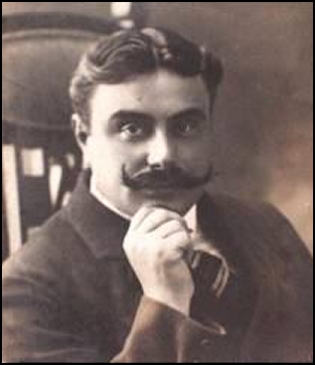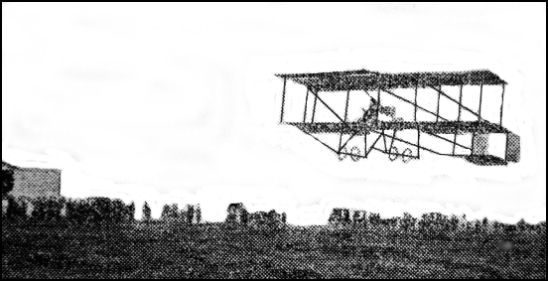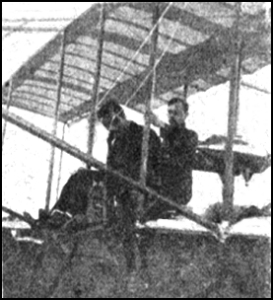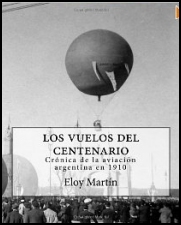
1881- English Version |
 |
Contributed by Eloy Martín |
|
The February 10 meeting rooms was presented at the Aero Club Argentino Moriand Louis and remained very low exposure profile awaiting the arrival of his Farman (3) biplane initially moved to Villa Lugano (4). Then moved to Campo de Mayo and operated from the auxiliary track prepared by the Company against the Air Argentina (5) School classes (now Air Assault Regiment 601). He was afforded a precarious shelter located in the This sector of the military installations. The aircraft was armed and ready to fly on 11 February and first flew on 14. The biplane, excessively heavy, somewhat marred the first flights with passengers who were tried between us and the four-les participants were Lt. Raul Eugenio Goubat (6) and Jorge Alejandro Newbery . Days later, with a model something lighter and slightly smaller than Valletón (Model I bis (7)) introduced Mantels & Co. signature. Airline facilitated by Argentina, was devoted to instruction and then took over for a short time the first formal driving school that was established in the Palomar. |
 |
(Foto diario La Prensa 17 de febrero de 1910) |
|
On 20 June he received the brevet of a pilot awarded by the Aero Club Argentino. Returning to his country
given origin-accessible, along with Louis Boyer, the airplane pilot brevet No. 304 (8) was granted on 23
November of that year using my-mo to examine a 50 hp Antoinette monoplane. In France negotiated the contract
Max Paris Flyer LeClerc as instructor Airline Argentina. On November 23, 1910 board examination yielded a 50 hp Antoinette creditor becoming the brevet No. 304 awarded by the Aero Club of France. 1. Very probably the Henry Farman III Race (race). 2. Flight Magazine. http://www.flightglobal.com/pdfarchive/view/1909/1909% 20 -% 200781.html 3. Diario La Nación, February 10, 1910. 4. This model of plane had made its first flight on April 6, 1909 as his car plane main features were: length. 1345 m, height 3.48 m, breadth 10.80 m, wing area 42 m2, weight 550 kg maximum take-off equipped with a motor-vo rotati Gnome Omega 50-hp, allowing it to reach a maximum cruising speed of only 60 km / h. 5. Surely intervention prepared by Lieutenant-Colonel Antonio Arenales Uriburu, then president of Argentina S. Air Company A. and Inspector General of Military Construction. 6. By then assigned to the School Classes. 7. The model Ia Henry Farman was one experimental type car, making its first flight on 27 August 1909. Its main character-istics were: length 10.32 m, height: 3.08 m, breadth 10.50 m, wing area 40 m2, maximum takeoff weight 530 kg (only 20 kg lighter than Valletón), motor Gnome Omega 50 HP also allowed him to reach a maximum cruising speed of only 60 km / h. 8. Retrieved from Internet: http://www.past-to-present.com/vieilletige.cfm?id=305 |
 |
 |
(Foto Revista Nacional de Aeronáutica 1960) |
(Foto revista Caras y Caretas N.º 595, 26 de febrero de 1910) |
| Fuente: MARTIN Eloy (2010). Los vuelos del Centenario. Crónica de la aviación argentina en 1910. Createspace. DBA of On-Demand Publishing LLC. Amazon Group. United States of America. |
 |
LOS VUELOS DEL CENTENARIO Crónica de la aviación argentina en 1910 (Spanish Edition) Eloy Martín Product Details Paperback: 246 pages Publisher: CreateSpace (December 7, 2009) Language: Spanish ISBN-10: 1449947247 ISBN-13: 978-1449947248 Product Dimensions: 10 x 8 x 0.6 inches |
|
Editorial Reviews from Amazon Books Product Description ""The flights of the centennial. Chronicle of aviation Argentina in 1910" is a personal project that emerged as a result of its continued enthusiasm and passion for aviation. In this paper the author develops a detailed study of the context in which aviation unfolded in those years. Pilots, aircraft and domestic aviation projects are integrated in this work, along with a thorough analysis of the flying sites used in Argentina. About the Author Born in Buenos Aires in 1956. During the 80 was formed as an aviator, commercial pilot and first class flight instructor. In 2006 he obtained a Bachelor of Science in Education and a year later, has dedicated more than twenty years of aeronautical research. His work as a historian, approached from a scientific perspective, are published in major national and international media are required as essential reference material both for those who start the case, as for most experienced researchers. Currently teaches at the National Technological University |


|